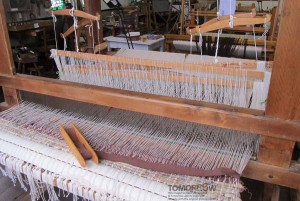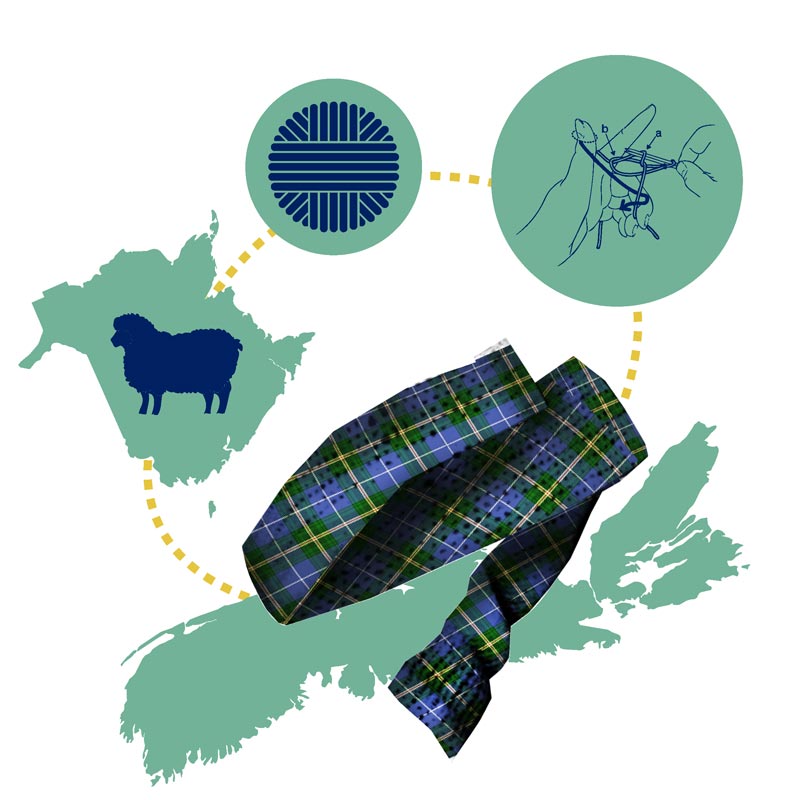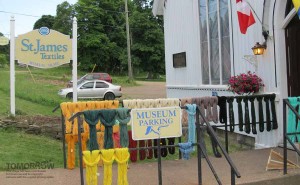The fields of blue, and ‘scratchy as hell’

What are we wearing, by Jason Skinner, artist in residence. Creative Commons, Attribution-NonCommercial-NoDerivs 3.0 Unported
The summer breeze used to blow across fields of blue in parts of New Brunswick. Where now flax is grown as a “superfood” and source of omega-3, in the 19th century, it was used to weave linen.
Those days are gone except in the museums keeping the memory alive, such as at St James Church Textile Museum in Dorchester.1
The frame church, built in 1884, became a museum in its later life to display the artefacts of the late 1800s and the “hands on” chance to try weaving that is part of so many historical displays.
Museum supervisor Denyse Milliken said she was taught by Betty Adams who learned weaving from Pamela Black, who started the collection of textiles and tools. As much as she displays historical items, she is also a passionate weaver herself.
“I think weaving is absolutely magical,” said the 49-year-old by phone. “It’s a magical process, to go through the whole process. I will talk to elementary schools and how important all these skills were and some have never seen someone sew on a button or knit.
“I value those skills, quite a lot.
“I was explaining to somebody about one of the blankets we have that was all darned and patched and everything, and we don’t really know the history of this blanket, but it may have been the only blanket that somebody owned.
“And was it because they were poor? Or was it because they were holding on to this blanket because it had sentimental value? Chances are it was because they were poor and it was the only blanket they had.
“I find textiles being part of this throw-away society that we have now, that nothing’s built to last and there’s no pride in craftsmanship. People are so happy to buy a $4 t-shirt from Walmart and then when it falls apart they get mad.
“Whereas when we only had enough clothes to fill a quarter of the closets we have now, and something had a rip in it, it didn’t happen third time you washed it, it probably happened six months into owning it and you could repair it because you valued it more.”

Rag rug being woven at St James Textile Museum, Dorchester, New Brunswick. Courtesy Denyse Milliken.
Ms Milliken goes to schools to demonstrate spinning and weaving, and captures the imagination of the boys.
“Some of the kids think it’s really neat,” she said. “When I demonstrate at the market too, quite often it’s little boys that will come over and take a look, more so than little girls.
“The men quite often were the weavers because they had the upper body strength – it is quite a physically demanding thing because you’ve got to get the loom all set up and you’re leaning over it and underneath it tying up things and then you’re threading it. And if you’re working on a wider loom, you have the strength to shoot the shuttle across and then beat fabric – that can be physically demanding for some people. It takes a while to get the feel of it and then after you’ve got the feel of it, you build up your strength.
“There [are people] in this age group in the 20s and 30s now who are interested in home spinning and organic food and living simpler lives, they’re interested in slow food and local food and they’re starting to get interested in the possibility of local textiles.”
350,000 yards of cloth
Spinning, weaving and other parts of textile production used to be at the core of New Brunswick life – they had to be when there was no “away” or box-store alternatives filling urban sprawl.
Dr Judith Rygiel2 spent the first two decades of her 44 years of weaving as an artist, largely working in wool, before moving into academics and silk and becoming an expert on Acadian textiles and 19th century New Brunswick. Originally from Moncton, she spoke to Tomorrow from her home in Ottawa.
In her work on census records from Westmoreland and Charlotte counties, she found quite different organisation of textile mills and varying numbers of workers. The statistics only go as far as 1871 because census records from the decades following were destroyed in the 1960s.
But they show – and Dr Rygiel described these as conservative figures – at least 500 people weaving 500–700 yards of fabric per year. Potentially totalling 350,00 yards, that’s far more than households would need, meaning it was sold at shops. This was the homespun economy, and while industrialisation elsewhere led to a sharp decline in spinning and weaving at home, New Brunswick was marked by slower change and “industriousness”, said Dr Rygiel.
“In NB and other places in the Maritimes, big time industrialisation didn’t happen until 1877,” she said. “[Prime Minister] John A Macdonald had this national policy of trying to encourage self-sufficiency and that’s when the cotton mills kind of started growing.
“In the [United] States it was 1820; in Canada it was 1877. That’s quite a bit different.
“When you look at the mill production of fabric, which competed a lot with home production, the mill factory workers did not require a great deal of skill. You just went to work, came home.
“Home production kind of peaked in the 1880s when industrialisation happened – this is when home production took a dive in New Brunswick and Nova Scotia. In Ontario it happened sooner because industrialisation happened sooner.”
 When larger mills of up to 500 people started up, such as in Marysville, that changed the scope of production. But the homespun economy was not always measured the same way, with census takers not always asking the same questions.
When larger mills of up to 500 people started up, such as in Marysville, that changed the scope of production. But the homespun economy was not always measured the same way, with census takers not always asking the same questions.
“They were really vague,” said Dr Rygiel. “In Northumberland County I found almost 400 people declaring small business, whereas in the other counties, nobody declared a small business of textiles. Yet in Westmoreland County, there’s some of the people there who are making 5 or 700 yards of fabric. You don’t make 700 yards of fabric for your family. This is going out to customers of some sort, and it’s mostly the outdoor workers.
“Farmers, fishermen, lumber people – that’s the economy that really pushed this whole thing. It was basically a rural economy: outdoor people need strong, sturdy fabric. You might not have been getting it from the mills and you may not have been able to afford it, so cost avoidance is a big part of the story too.”
Dr Rygiel said that anyone making more than 100 yards of cloth is putting it into the market, and she found ads in Fredericton asking for readers to supply socks, mitts and homespun fabrics. And it was durable.
“Have you ever worn that stuff? I have. It is scratchy as hell,” she declared. “But it’s durable, for the kind of work that was being done. Somebody’s not necessarily going to dress up in a suit, but that happened and in America there was a whole trend in the 1850s to dress up in home spun. And in Quebec too in the rebellion years of 1838 people were encouraged to wear home spun as patriotic fabric.”
She added: “People don’t usually write about this kind of thing. One of the other issues with textile production and some of the other crafts, is that people don’t write about it. It’s the same thing as making a cake – well, who’s going to appreciate a cake? A cake is a cake and cloth is cloth.”
Most of the weaving was initially done by men, a skill brought from Scotland. But the sons did not pick up the craft and it was left to the daughters as men found more profitable work.
Training schemes or apprenticeship programmes common in Scotland were not evident in Canada, said Dr Rygiel. The men were pioneers and some may have continued on weaving, but then found more profitable work. And many, when they arrived, had more important needs to meet, such as building a home and clearing land, rather than making cloth.
She said: “When they had enough money to be able to buy product instead of making product – because it’s labour intensive and time intensive – they might make a decision about where they’re going to put their money.
“The gender thing had always been part of the household, but maybe not the weaving part – the weaving was a male activity up until maybe the beginning of the 19th century. The immigrant men still continued some of that, but women took over some of those roles because they [fit] in with some of their other activities whereas men were out there chopping down trees and whatever else they had to to make a household. Is it more important to put a roof over your head or to make cloth?”
Nobody got rich from weaving, something Dr Rygiel admitted remains true today.
Crafts for art
And yet crafts came to be viewed as the potential saviour of the economy in the revivalism of mid-20th-century Nova Scotia. Mary E Black was the figure instrumental not only in pushing the newly designed provincial tartan, but also pushing her own aesthetics and tastes for crafts, which still linger today.
Historian Dr Erin Morton, from the University of New Brunswick in Fredericton, focuses on the visual and material culture production in North America, researching the connection between textile production and therapeutic culture.3
She said the tendency with arts and crafts revivalism in Euro-American societies in the late 19th and early 20th century has been to “valorise and romanticise rural textile production”.
“This was a very common feature of urban, middle-class consumers. On the one hand, rural producers were, and I’m speaking very broadly, producing for home use. Textiles were things that were made for the home, often out of scrap material.
“The home economy of textiles is one thing. The consumption of that type of production outside of a home economy then brings that textile item into a new realm [of use].”
Black, who started working for the department of handicrafts in the Nova Scotia government in 1943 and until 1955, had trained as an occupational therapist, before traveling to Europe to find people serious about revivalism. She did a residency at a school in Sweden in the 1930s and brought back particular aesthetic ideas, which often meant rejecting what objects looked like, even if the skills used to make them were fine. The crafting worked, but the finished craft did not.
Dr Morton said in Nova Scotia she wasn’t pleased with the pre-existing home-made craft objects.
“She didn’t really like the colours. She didn’t like the style. So she made her career by re-teaching people how to make ‘better’ things. And then once those things were made better – I’m speaking facetiously of course – they were distributed to a new audience, and largely tourist audience, but also, importantly I think, urban middle-class elite audiences that would be buying these things as decorative objects, as art objects, rather than as useable objects.
“They were used in a different economy than they would have been used by the producers in their homes. They were used in the homes of [the] elite in a different way.”
Revivalism was fed by the perception that a type of handwork was being lost to industrialisation and the machine.
“There was a real anti-modern sentiment to it,” said Dr Morton. “So even though [a loss of homemade items] never really happened, there was a fear of that happening. [And] especially in Atlantic Canada, that never happened. It’s not as if people don’t make textiles any more by hand. It’s just done differently and for different reasons.
“[Black’s] idea was that she could take the base level of technical skill and improve it with good design, and also teach people to do it for different reasons. So there’s kind of this classic arts for arts sake rhetoric behind this kind of thinking. On the one hand historians have shown that Mary Black was a commercial anti-modernist, [and] she was very interested in making things for economic sustainability in Nova Scotia. She saw a gap in the Nova Scotia economy that she wanted to fill. But on the other hand she also had very specific aesthetic problem that she wanted to solve.
“She wanted to take what she saw not only in Sweden but also throughout New England. I wouldn’t be surprised if some of the same ideas were circulating [in New Brunswick at the time] as well.
“Black was not a unique apostle of these ideas – they existed throughout the region.”
The tartan is an example of something that Mary Black justified aesthetically, but was perfectly happy to have machine produced and sold en mass. When Camilla, the Duchess of Cornwall, visited Nova Scotia in May 2014, the tartan was on her lapel.4
Dr Morton said tartans, and art more generally in English Canada, was frequently used to distinguish the country from the United States, and impose a colonial mastery over the land.
“Culturally speaking,” she said, “it was very important to establish that European settlers had historical roots here, even though they didn’t, and often that was done through art and cultural objects.
“[It was] the idea that Canadians – English Canadians in particular and French Canadians to a certain extent – were participants in a long history. If the Group of Seven is painting a landscape, it has an aesthetic trajectory that can be traced back to Britain, even though that tradition has been written about as uniquely Canadian at the same time.
“That has very clear connections to wanting to establish colonial dominance over indigenous people, because there wouldn’t have been that effort to historicise something that really was contemporary, in the late 19th, early 20th century in particular.
“While someone like Mary Black wanted to raise [textiles] to the status of [an] art object by the way that she designed and curated them, and in her mind teaching people how to make something that is better, part of that is because there is a rejection of what was here. There is a rejection of not only settler textile traditions but also indigenous textile traditions, which did exist and have a much longer history.
“There really was an effort to marry the aesthetic with the European model and also to try again to historicise settler occupation of the land through their textiles.

Illustration by Artist in Residence Jason Skinner. Creative Commons, Attribution-NonCommercial-NoDerivs 3.0 Unported
“Why would someone like Mary Black in 1953 want to promote a tartan, for example? There’s a racialised implication there, as historians have shown, to connect Nova Scotia with Scotland. Part of the idea is to make something that is a contemporary object historical by giving it a lineage that doesn’t really exist. But it calls up a lineage when you look at a tartan because you think of it as historical – you think of it as very old and people today think of the Nova Scotia tartan as very old. Most people don’t know that it was invented in this manner or that it only goes back to the 1950s.”
And there were whole charts of what the tartans that Black helped to promote meant, encouraging Nova Scotian weavers to produce many kinds: the blue of the sea, the grey twill of a French girl’s dress, and “Empire Loyalist yellow”. Everything was meant to be rooted in the land. Except that it was Mary Black’s definition of the land. Textiles certainly came from the land already, but they didn’t meet her aesthetic criteria. And in some cases, they didn’t meet the politics.
“Mary Black’s work was definitely a cultural and economic success to a certain extent,” said Dr Morton. “The fact that the Nova Scotia tartan is a recognisable object and something that is collectable and reproducible and that people buy, I would say, is enough evidence to say that she was successful.
“Was it successful in lifting Nova Scotia out of economic depression as she had intended to do? Absolutely not. And Black specifically missed a lot of opportunity because of her aesthetic ideals. She missed the opportunity to work with many makers who didn’t quite fit [into] her mould.
“She really was tapping into a mid-century idea that tourism could benefit Atlantic Canada economically. I don’t think we’re quite out of that. But I think at least there is perhaps greater understanding now of the negative side of that type of thinking, to try to recreate an area according to a tourist ideal. I think anybody with half a critical mind could see how that could go wrong.”
Living museums today – such as St James’ Church Textile Museum – portray a performance where you can participate and get a souvenir of a moment in time that can never truly be known. It commercialises a historical moment for tourist consumption, said Dr Morton. And that connection has a basis in the tourism economics that Mary Black pushed.
Black’s idea was not unique to her time period, putting people on display for the heritage industry.
“If you think about craft and economy, there’s been a long history of people trying to capitalise in one way or another on craft production for various purposes,“ said Dr Morton. “Often, in the moment, it is seen to have a very good mission. It’s seen to be taken up for very good reasons. In her time, and even now, people have very fond memories of Mary Black because she was somebody who was seen to take an interest in the work that people were doing and that she had genuine desire to improve the economy and to get people jobs.
“On the other hand, she comes in and says, ‘Okay, you’ve got some of the skills but you’re doing it wrong; let me show you how to do it better’.
“There’s a long history of people trying to do good things through craft work.”
Many of those good ambitions came at the expense of other types of production, working outside of the norm, either aesthetically or economically, said Dr Morton. “Mary Black very carefully chose the things that she wanted to advance and she was able to do that because of her government position, because it came with a budget, and because she had marked authority in her field. She was able to pick and choose what kind of makers she wanted to work with, and what kind of objects she wanted to produce.
“That’s a real historical lesson for anybody who’s kind of interested in this in the contemporary moment because I think that is often the case.”
The pride of the workers
Dr Morton said what’s often lost in the story of textile production is the many women and collaborative work behind them. And in northern New Brunswick, hundreds of workers in the past decade were more than familiar with the financial and community costs of attempts to impose a textile economy.
The story of Atlantic Yarns and Atlantic Fine Yarns – both owned by Sunflag Canada – could be an easy example for economists of failure. Around $80 million in taxpayer money was written off when the firm went bust in 2009.5 But Keith Steeves, who was then in charge of Local 208 with the Communications, Energy and Paperworkers Union (now the Unifor Union) remembers how non-New Brunswick the business was.
“I never had no background with the textiles,“ said the 67-year-old by phone. “I learned a lot while I was working there: how do you make the yarn and how it was shipped out to India through the States and all that. And they used to make t-shirts and bring them back to Canada. What really happened with Atlantic Yarn is, it was the market that really killed them.”
Cotton and orlon came in to New Brunswick, was processed, sent back abroad and then returned to North America as products that, even after tax revenue to the US or Canadian governments, still made them very cheap shirts for consumers. By the time of the third expansion of the business, Mr Steeves said they went too far, ultimately costing 360 jobs at two plants at Atholville and Pokemouche.
“When they came to Canada,“ he said, “we went on a wildcat strike because they weren’t treating the people right. I don’t think any of them knew Canadian law.
“We even fought about certain holidays, like Remembrance Day. One time they didn’t want to give us that and we told them we’re allowed so many holidays in a year. And then they start fighting with us. So we decided one time, ok, we’re going to fool them, we’re going to just walk out. We walked out for nine weeks. And they lost a lot of money then.
“The old saying is they were trying to bite out more than they could handle. They used to make t-shirts, ship it to the US. The t-shirt might cost $2.50 to be made over in India. By the time it got to the US, they had to pay a tax on that t-shirt to bring it into Canada. So you’re looking at a t-shirt now that’s about $8 by the time it hits the US border. And by the time it hits the US, into the stores, you’re looking at $12 for each t-shirt.”
Did Mr Steeves and his colleagues want to work in textiles? Now a night security on the Campbellton waterfront, he said: “People enjoyed working there. They were good paying jobs.”
Were the Atlantic Yarns jobs good because taxpayer money brought in an outside employer? Were the workers productive enough? Was it a sign of the economic decline that continues to plague New Brunswick?
PART 3: Is New Brunswick unravelling?
- St James Church Textile Museum. ↩
- Dr Judith Rygiel. There is also further information in “Survival or adaptation? Domestic rural textile production in easter Canada in the later nineteenth century”, Beatrice Craig, Judith Rygiel and Elizabeth Turcotte. Agricultural History Review 49, II, pp 140-171. ↩
- Dr Erin Morton. ↩
- The palace told Tomorrow the tartan was a gift and they did not know where it was made. ↩
- Past news coverage from 2009 is available here and here, and the PWC report on the factories here. ↩


